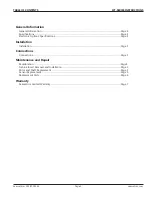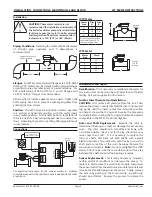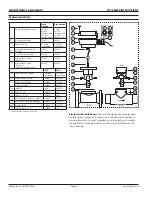
WT-SERIES INSTRUCTIONS
Seametrics • 253.872.0284
Page 5
seametrics.com
Installation
Piping Conditions.
Installing the meter with 10 diameters
of straight pipe upstream and 5 downstream is
recommended.
Flanges.
For WTS meters, standard flanges are 150 lb. ANSI
drilling. PVC meters can be installed with optional flanges
according to pipe manufacturer’s recommendations. For
PVC a bolt torque of 20-30 ft-lb for 3” and 4” flanges, and
35-50 ft-lb for 6” flanges is recommended.
Either partial or full-face gaskets can be used. Tighten the
bolts evenly. Use care to prevent a misaligned gasket from
entering the flow stream.
Position.
The WT-Series are all-position meters, operable
in a vertical or horizontal position, with the meter insert
in any radial position. A horizontal position is preferred if
there is a risk of air becoming trapped due to constant low
flows. Operating the meter in partially-filled pipe will result
in inaccuracies.
Connections
For operating instructions for the various electronic modules,
consult the manual for the specific module, included with the meter
at purchase.
CAUTION:
These water meters are not
recommended for installation downstream of
the boiler feedwater pump where installation
fault may expose the meter to boiler pressure
and temperature. Maximum recommended
temperature is 120˚ (PVC) or 200˚ (Metal).
10X Dia.
5X Dia.
Straight coupling can
be part of length
FLOW
WTP
Loop Power Supply
24-36 Vdc (dep on device)
To Other
Control
4-20 mA De
vice
Red
White
Black
Powe
r
Sensor
Puls
e
Output
Sensor Output
Black
Black
Red
INSTALLATION, CONNECTIONS, MAINTENANCE AND REPAIR
WTP Meter
WTS Meter
Maintenance and Repair
Recalibration.
If it is necessary to recalibrate the meter for
any reason, this can be done by any Seametrics-authorized
facility. Call your supplier for information.
Turbine Insert Removal and Installation.
CAUTION:
First remove all pressure from the line.
Then
remove the screws or bolts that hold the insert in place and
tug gently until the insert comes free. A twisting motion
can help to loosen the O-ring seal. Reverse the procedure
to reinstall, after coating the O-ring with lubricant (plastic
compatible in the WTP).
Do not overtighten.
Rotor and Shaft Replacement.
Examine the rotor to
determine if bearings or shaft are damaged or excessively
worn. The rotor should spin smoothly and freely, with
no visible wobble. Back and forth play should be very
minor, less than 1/64”. If it is necessary to replace the
rotor or shafts, first back out both shafts with a small
blade screwdriver. The rotor will come free as soon as the
shaft ends come free of the rotor bearings. Reverse the
procedure to reinstall.
Note:
Do not overtighten the shaft
screws.
Check to be sure that a small amount of free play
between the shaft ends and the bearings remains.
Sensor Replacement.
This is rarely necessary. However,
certain electrical conditions can damage the sensor. To
replace it, first remove the electronics module. Disconnect
the sensor leads from the electronics module terminals and
remove the threaded plug over the sensor. Finally, remove
the sensor by pulling on the sensor leads. A gentle tug
should be sufficient. Reverse the process to replace the
sensor.
Meter
Size
Dim
A
Dim
B
3”
12”
6.5”
4”
14”
7.0”
6”
18”
8.5”
NOTE: Flange options face-
to-face dimension (“A”) is
the same as plain ends.
A
Optional
Flanges
B
Optional
Flanges
Meter
Size
Dim A
3”
12”
4”
14”
6”
18”
8”
20”
A
Flange
150 lb
drilling
Summary of Contents for WTP-400
Page 2: ......


























